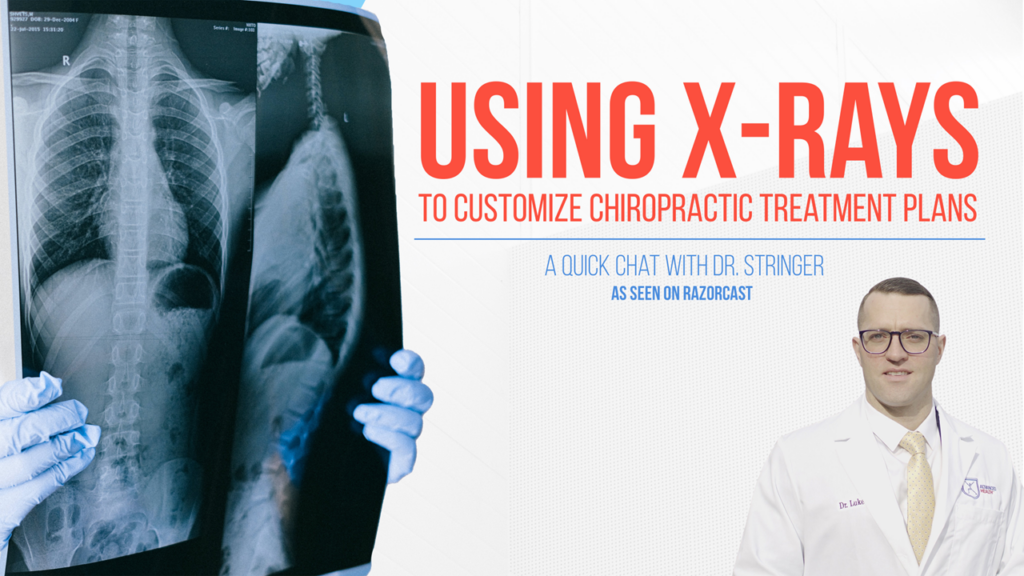
We are an objective chiropractic clinic, and we use objective findings to dictate our treatment recommendations. And an objective finding is having x-ray analysis performed on the spine. It really helps us make great clinical decisions. It helps our patients understand what is causing and driving their pain, and it gives us objective data we can work off and show improvement as we go through the treatment plans.
We have digital x-ray systems in our office and our chiropractors are skilled in reading them. We actually have all our x-rays read by a DACBR. A DACBR is a chiropractor who graduated as a chiropractic student, then spent several years extending their scope of practice to officially be a chiropractor version of a radiologist.
We also use software called PostureRay which digitally analyzes your x-ray and gives you biomechanical feedback. It gives you, to the millimeter and to the percent of your spine and where it shifted, if it has shifted. This is awesome because it creates really detailed analysis for the chiropractor so we can put together a really detailed treatment plan. It is awesome for our patients to be able to leave the office with some objective findings of what is causing and driving the pain.
Our x-rays are designed to do several things. One, to examine the condition of the spine. So, is that spine healthy? Do we have any inflammation, any lesions, any breaks, any fractures, any degenerative changes, any spinal conditions such as DISH, because we need to know about that to make a good clinical decision on treatment referral, et cetera. And in our office, we practice Chiropractic BioPhysics which is studying the biomechanics of the spine, which is the shape of the spine. So, that is essentially what our x-ray analysis is done for, to rule in and rule out conditions, and then obviously also to biomechanically adjust the shape of the spine.
Now any moveable joint in the body is x-ray able. When you x-ray joints, you’re not necessarily looking for alignment per se, although if you’re x-raying the wrist, you want to check the alignment of the bones in the wrist, same in the ankle. And then in the other joints you’re looking for loading patterns. For instance, in the knee, do we have shifts, do we have degenerative changes? So, x-rays are great, the gold standard for bone. Any joint in the body that moves, we can x-ray the joint to figure out alignment, any structural damage, any other quirky things that might be going on in the joint.
X-rays allow us to make good clinical decisions and obviously all those clinical decision dictate type of treatment. So, physically what you’d be doing within the visit, how often you need to be coming in, and for how long a period of time.
Some patients might come with some really quirky misalignments where the head has gone forward, it’s also shifted laterally to the left, and then it’s rotated to the right. They are really hard conditions to treat, and the setups and contractions are quite complex. So, obviously when we set the patient up, we want to be checking in on the patient and making sure that setup is doing its job and we’re seeing some good change. And if it’s not, figure out why not, and then obviously make changes.
Our patients who go through corrective care always like to have x-rays taken at the end of the corrective care, because they’ve been applying themselves two, three times a week for eight to twelve weeks and they want to see objective change through all their hardworking endeavors. So, we typically take x-rays at a bare minimum at the beginning of the treatment plan, at the end of the treatment plan; we’ll go over a pre-treatment plan x-ray, a post-treatment plan x-ray.
If our patients have been consistent with their treatment, particularly with their traction, then we’re going to show them some good objective change. Patients love to see that. It’s essentially just validating all their hard work and effort. For that, they’re going to get long-term improvement.
From there, we can recommend ongoing treatment outside the office regarding their need to continue doing traction at home that we can prescribe. We recommend a sit-stand desk (everyone should be using those). We’re educating our patients on postural breaks that they need to do throughout the workday, staying out of flexion, so keeping your chin off your chest. We follow up on their rehab, for those muscles that we’ve got active to keep the spine alignment, and we make sure they follow through on that.
So yes, x-rays pre- and post-treatment allow us to make good, clear decisions and then show the team the effectiveness of the treatment that we just performed.
